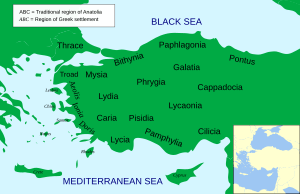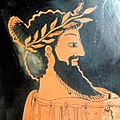Lydia facts for kids
Lydia was an ancient kingdom located in Anatolia, which is a large peninsula in modern-day Turkey. It was found in the valleys of the Hermus and Cayster rivers. For about a century, from the mid-600s BC to the mid-500s BC, the Lydians were the most powerful people in Anatolia. They are famous for being the first people to make coins from gold and silver.
Contents
About Ancient Lydia
Lydia was a very important kingdom in the ancient world. It was located in a rich area with fertile land and rivers. These rivers, like the Pactolus, carried gold dust, which helped the Lydians become very wealthy. Their capital city was Sardis, a bustling center for trade and culture.
The Lydian Kingdom
The Lydian kingdom grew strong by controlling important trade routes. These routes connected the Aegean Sea to the lands further east. This allowed them to trade goods and ideas with many different cultures. The Lydians were known for their skilled craftspeople and their beautiful goods.
First Coins in History
One of the most amazing things the Lydians did was invent coins. Before coins, people traded goods using barter (swapping items) or by weighing out precious metals. The Lydians started making small pieces of metal, usually electrum (a natural mix of gold and silver), with official stamps on them. These stamps guaranteed the value of the metal. This made trading much easier and faster. This invention changed how people did business forever!
King Croesus and His Wealth
Croesus was a very famous king of Lydia. He ruled for about 14 years, starting around 560 BC. He was known for his incredible wealth. People often said "as rich as Croesus" to describe someone with a lot of money. His kingdom was full of gold and silver, which he used to create beautiful treasures and buildings.
The End of the Lydian Kingdom
Croesus's rule ended in 546 BC when he was defeated by Cyrus the Great, the powerful king of Persia. Cyrus led the Persian army to conquer Lydia, and Sardis fell. After this defeat, Lydia became part of the vast Persian Empire. Even though the kingdom ended, the Lydians' legacy, especially their invention of coinage, continued to influence the world.
Images for kids
-
Map of the Lydian Kingdom in its final period of sovereignty under Croesus, c. 547 BC.
-
The temple of Artemis in Sardis.
-
Sardis Synagogue.
-
Portrait of Croesus, last King of Lydia, Attic red-figure amphora, painted ca. 500–490 BC.
-
Tomb of Alyattes.
-
Xerxes I tomb, Lydian soldier of the Achaemenid army, circa 480 BC
See also
 In Spanish: Lidia para niños
In Spanish: Lidia para niños














